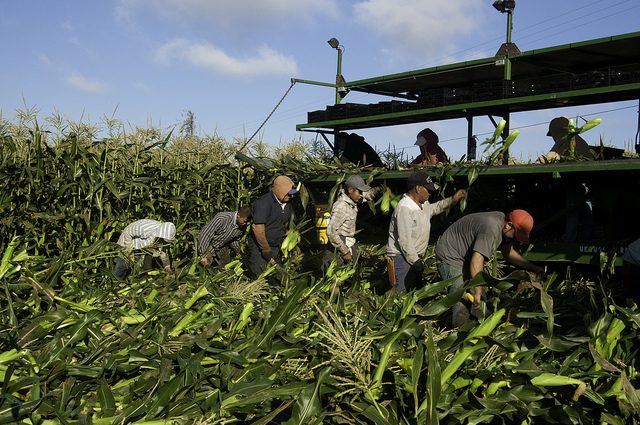
Migrant workers harvest corn on Uesugi Farms in Gilroy, CA on Wednesday, Aug. 28, 2013. USDA photo by Bob Nichols. Via flickr, CC BY 2.0.
ICE is zeroing in on dairy farms, which rely heavily on immigrant workers. Immigration agents recently raided a private farm in New York without a warrant to detain a dairy farm employee, leading many to call for an investigation into what actually happened at the farm and what can be done to protect the rights of those on private property. Unfortunately, we expect to see more of these types of warrantless raids—at farms and other locations where there are immigrant populations—so we thought it’d be important to once again share what to do if ICE comes to your buildings. Important note: dairy farms that employ immigrant labor produce 79 percent of the U.S. milk supply, according to Mother Jones. If immigrant labor were eliminated, retail milk prices would rise by 90 percent, according to researchers. We know we’re preaching to the choir, but it has to be said. (And feel free to recirculate this Shelterforce informational graphic: Do Immigrants “Take Our Jobs”?)
Some families who were displaced by 2017’s hurricanes are still homeless and living in hotels, waiting for the Federal Emergency Management Agency to decide on a long-term housing strategy for them. NLIHC’s Diane Yentel wrote an op-ed in the Orlando Sentinel taking the agency to task for its recurring threats to evict people from the hotels (today was one of those deadlines, now moved to May) and calling for it to step aside and allow HUD to get these families into more permanent housing under its Disaster Housing Assistance Program.
We like what’s happening over in Chattanooga. The city has a couple of underdeveloped municipal buildings that it will convert to affordable housing and office space, according to a recent piece in Next City. This idea is part of the city’s efforts to foster inclusivity.
Trump’s executive order in early April on work requirements for recipients of government benefit programs was another fly-in-the-face of good sense move, particularly because of the fact that this singled-out population already works, often multiple jobs. HUD Secretary Ben Carson subsequently introduced the agency’s “Making Affordable Housing Work Act of 2018,” claiming a goal of reducing the waste and confusion of current rent policies (in its defense, reducing income verification reviews to once every three years as opposed to annually does make sense). Congress has the final say.
There are so many nuances in the YIMBY movement, and this recent op-ed about the racist history of LA’s land rules furthers the point.
You should check out this piece from Build Healthy Places Network about the harmful effects of unstable and unsafe housing on a child’s brain development. While you likely know about this health and housing connection, the author did a wonderful job collecting the data and providing a good overview that makes the research hit closer to home, as it should.
As weather like hurricanes and floods destroy coastal properties, low-income residents who lived in those areas are finding it more difficult to rebuild. These residents are being pushed out from the coastal areas in what’s being called climate gentrification. “Ever-stricter building requirements make homes more expensive to construct. Rising premiums for federal flood insurance make them costlier to live in. And when local governments issue bonds to pay for sea walls and other protections, as Miami did last year, taxes are often raised, further increasing costs,” according to The National. If there’s one story you read this week, it’s this one. Mother Nature isn’t going to be backing down anytime soon.
Marijuana to the rescue? Denver’s mayor hopes to build and/or preserve thousands of affordable housing units in the city by increasing the tax on marijuana sales from 3.5 percent to 5.5 percent. The move is expected to generate $8 million a year.
What is really driving the wealth gap between whites and Blacks and what can be done to bridge the divide? While homeownership has long been touted as a fix, “doing away with the homeownership gap, by itself, will not create wealth parity for Blacks and whites,” according to this City Lab piece. According to a recent study, reparations should be meaningfully considered.
Remember that story about the community land trust that had a goal of acquiring 700 homes in Denver? Sadly, it looks like the plans aren’t working out so well. Talks between Elevation Community Land Trust and city officials have been lagging for months, and the trust is discussing the proposal with other municipalities.
Early results of state submissions for Opportunity Zones are in, and most are actually for deeply distressed neighborhoods. 18 states submitted applications by the initial deadline, and 22 percent of them selected areas with poverty rates below 20 percent, and another 19 percent selected neighborhoods that are already gentrifying. If the purpose of Opportunity Zones support is to spark investment in economically distressed areas—not provide subsidy to investors already active in a neighborhood—states that have yet to submit their lists should know that people are paying attention.
Incorporating green building elements is perceived to be more expensive in affordable housing, but a recent post on the How Housing Matters blog challenges the idea. It also offer tips to developers for maximizing their green investment—including starting with small changes that don’t require a heavy lift by residents, and ensuring that residents are kept informed of and engaged in efforts to make living environments healthier and more energy-efficient.




Comments